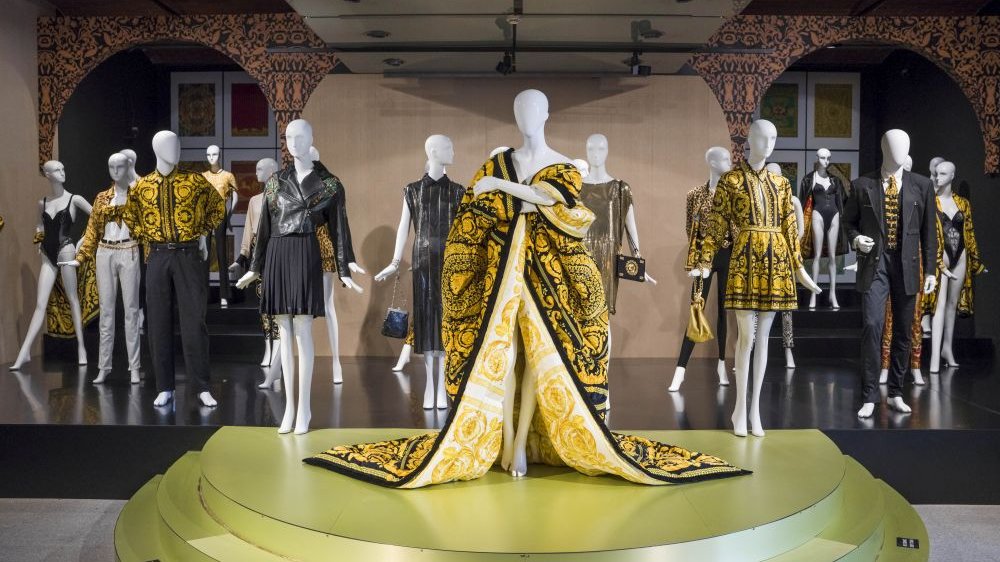Versace's collections have earned acclaim for their daring and baroque style. They evoke associations with extravagance and ostentatious displays of affluence, radiating an aura of glitz, lavishness, stardom, and allure that are reminiscent of both pop culture and operatic flamboyance. Versace seamlessly melds popular culture with high art, creating costumes for the prestigious La Scala Theatre in Milan as well as Elton John's concert tours. Contemporary fashion and pop culture are forever in debt to his genius that epitomizes boldness, unconventionality, and unbridled audacity, setting a new benchmark for luxury for all those who aim high and seek to exude self-confidence. He has created a fashion canon that keeps up with galloping progress. He mingled with pop culture luminaries, entrepreneurs, and the nouveau-riche tech industry elite during the 1990s. He has shattered gender norms in fashion, turning men into objects of sexual desire and women into icons of strength and predatory charisma. Versace emphasizes status, power, and aspiration. To wear Versace is to be at the vanguard of fashion.
Conceived by Wojciech Piotr Onak and guest curators Karl von der Ahé and Saskia Lubnow, the exhibition encapsulates the essence of ground-breaking collections. Within the intimate confines of the Courtyard Gallery, they trace Versace's artistic evolution and personal journey. Upon entering the first exhibition room, visitors are immediately confronted with his famous "barocco" model, not unexpectedly presented with a flair characteristic of the baroque style. The space adjoining the jewellery and footwear showcases, and shirts adorning the walls is dominated by a dozen or so mannequins sporting a plethora of outfits that share this distinctive motif. Von der Ahé and Lubnow sought to make a connection between the exhibition venue and Versace himself.
The linchpin of the "barocco" section was none other than Poznań's baroque Parish Church. Here, a symbolic temple to Versace was crafted, drawing loose inspiration from the church's layout. One of its walls artfully displays shirts arranged in the shape of a cross, echoing the patterns of Versace's creations. Opposite this "altar" stand mannequins assembled as a "congregation of worshipers" bedecked in Versace's creations. These sacral allusions underscore an intrinsic conflict that marked the designer's life: his relentless quest to free himself from the constraints imposed by his devoutly Catholic upbringing in southern Italy. One drawback to this ingenious spatial arrangement is that some mannequins remain inaccessible, preventing visitors from closely inspecting the details of certain works. Only later in the exhibition can they come up close with the exhibits.
The subsequent two rooms continue the dual narrative of art and biography. One endeavours to mimic the Warsaw Ballroom, the iconic LGBT club in Miami frequented by Versace, intertwining with the presentation of his men's fashion designs, ranging from tattered jumpers to chest-baring denim vests and lace underwear. This redefinition of men as objects of sexual desire, masterminded by Versace, is complemented by the famous collections known as Bondage and Cowgirl, which in turn redefine women as liberated, strong, and aware of their sexuality. The predominant themes here are black, gold, leather, and the iconic safety pins bearing a chimera's head.
The final part of the exhibition provides an overview of Versace's 1990s collections, distinguished by the designer's unparalleled creativity and versatility. Versace fused diverse inspirations, spanning from pop art to 1940s fashion, with an uncanny ability to navigate between extravagance and simplicity, resulting in an array of projects that epitomised diversity and resisted even the slightest repetition. On a biographical level, the exhibition invokes religious and sexual themes that portray Versace as a star. Its blinding flashes and loud music sweep the visitor into a whirlwind of pop culture madness.
The big strength of "Gianni Versace - Retrospective" lies in its dual narrative and the sheer number of the exhibits on view. And yet, despite the density of content, the exhibition's intimate scale leaves one yearning for more. Much is also required of its viewers as the plaques provide only a cursory clarification of the exhibition's concept and Versace's biography. While fashion aficionados will find this sufficient, neophytes may need to do their homework and engage in preparatory research into the cultural background of Versace's time to fully grasp the phenomenon of both the artist and his oeuvre. Nevertheless, "Gianni Versace - Retrospective" stands as a captivating homage to one of the greatest revolutionaries in the world of fashion. It not only showcases Versace's garments but also captures their spirit, a feat for which the curators undoubtedly deserve the highest praise.
Paweł Binek
translation: Krzysztof Kotkowski
- Exhibition: Gianni Versace - Retrospective
- Curated by Wojciech Piotr Onak
- Na Dziedziniec Gallery, Stary Browar (Old Brewery)
- Open until 30 January 2024
© Wydawnictwo Miejskie Posnania 2023


